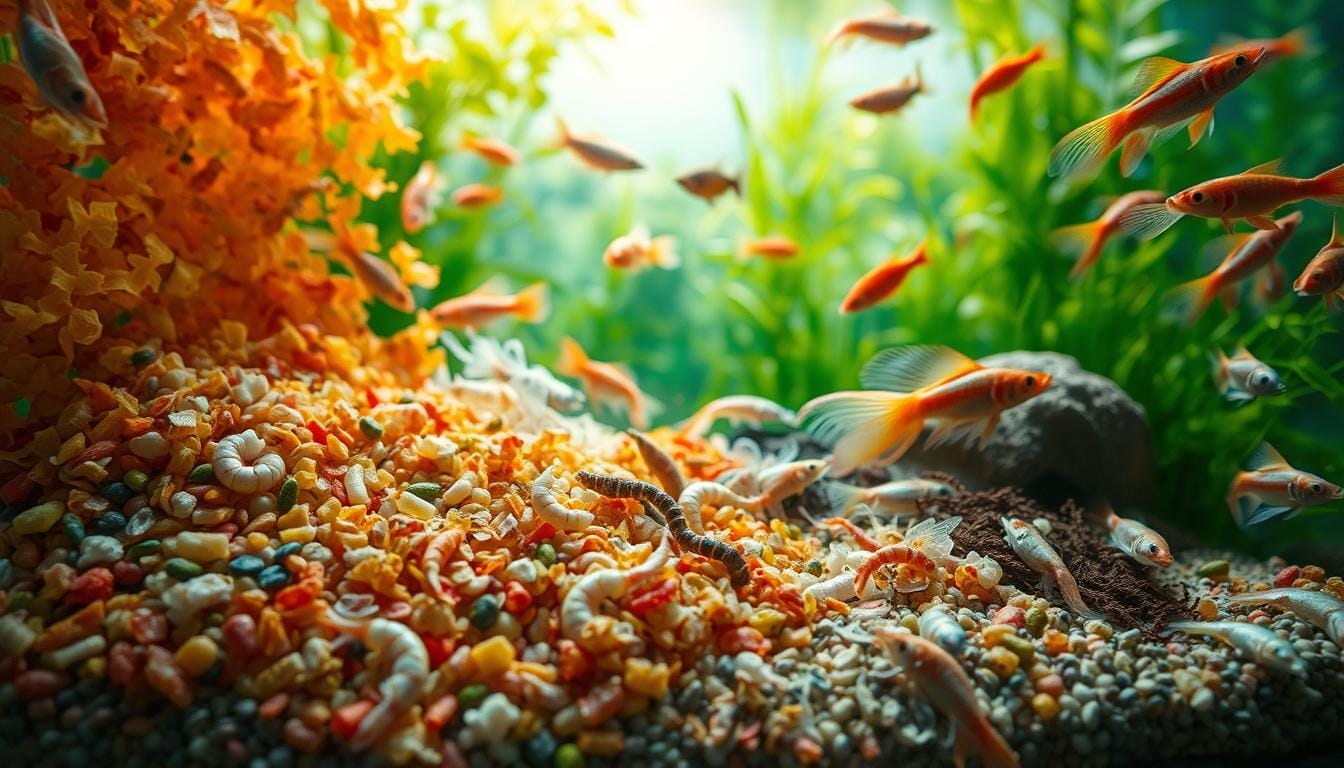
Solve Overfeeding Problems in Your Aquarium with Expert Advice
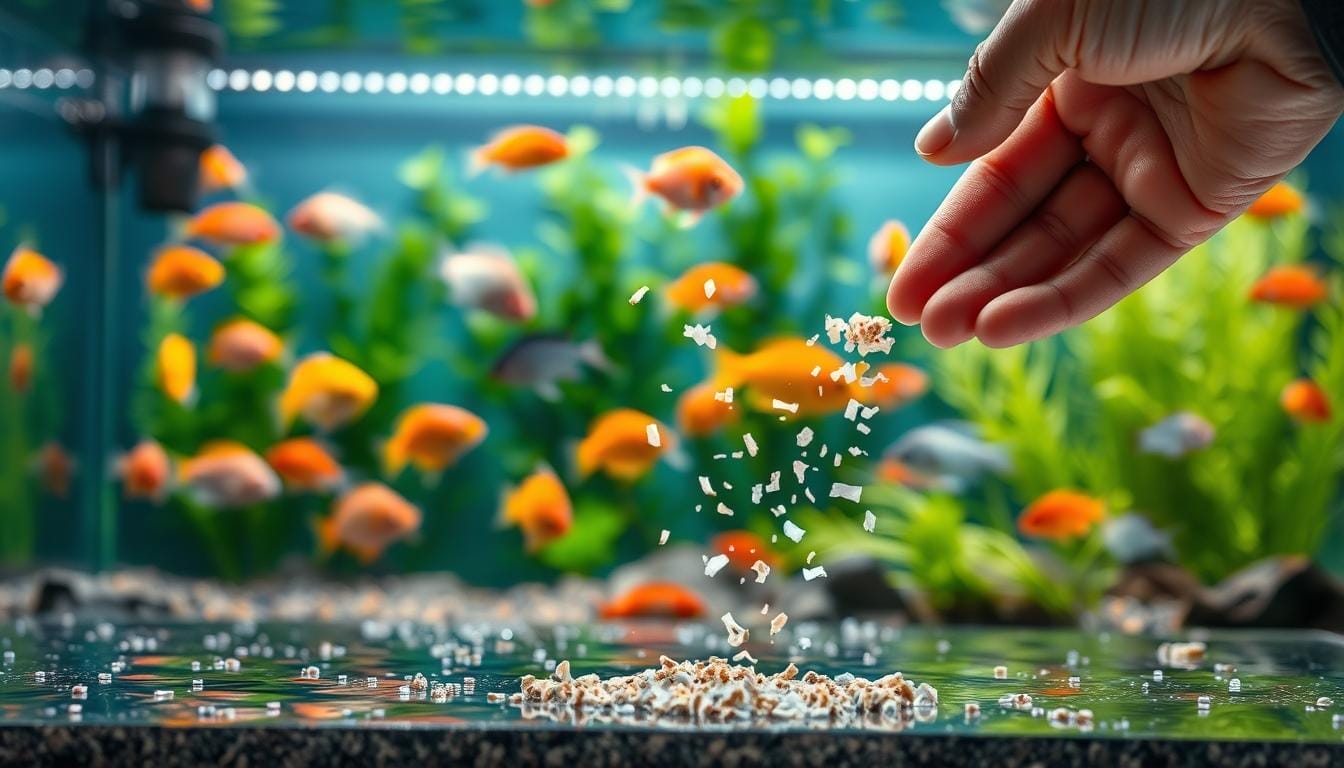
Did you know that 75% of aquarium owners accidentally shorten their fish’s lifespan through a common mistake? Excess food doesn’t just disappear—it transforms into invisible threats that compromise your tank’s delicate equilibrium. While your fish might eagerly beg for more, their health depends on your ability to strike the perfect nutritional balance.
Many enthusiasts overlook subtle changes like slight cloudiness in water or fish appearing less active. These quiet signals often point to an overloaded ecosystem struggling to process surplus nutrients. Left unchecked, this imbalance can trigger harmful chemical spikes and stress your aquatic pets.
This guide reveals practical strategies to protect your underwater world. You’ll learn how to interpret your fish’s true needs while maintaining crystal-clear water quality. We’ll help you create a sustainable routine that supports vibrant fish colors and optimal tank conditions.
By understanding portion control and observing natural behaviors, you’ll gain confidence in your care routine. Your aquarium isn’t just a container—it’s a living system that thrives when all elements work in harmony. Let’s explore how mindful feeding practices can transform your aquatic environment into a flourishing paradise.
Understanding Overfeeding Problems in Aquariums
Your fish’s constant swimming near the surface doesn’t always mean hunger—it’s nature’s way of exploring. Many aquarium lovers accidentally create unseen risks by misreading these behaviors. Let’s clarify what healthy nourishment looks like for your underwater friends.
What Does Excess Food Look Like?
Fish consume best in short bursts—their stomachs are tiny compared to ours. A good rule? Offer only what they finish in 2 minutes. Leftover flakes or pellets sinking to the gravel signal it’s time to adjust portions.
Myths That Lead to Messy Tanks
Three common beliefs need reevaluation:
- “Fish always act hungry” – They’re opportunistic eaters by nature
- “Big meals are better” – Small amounts 2-3 times daily match their digestion
- “They’ll stop when full” – Captive fish often eat beyond their needs
Watch for water clarity changes or slower swimming patterns—these hint at adjustment needs. Your tank’s conditions directly reflect feeding habits, making observation your best tool.
Identifying the Root Causes of Overfeeding
Your aquarium’s health starts with recognizing why extra flakes seem harmless. Many owners unknowingly disrupt their tank’s balance through habits that feel caring but create hidden risks. Let’s explore what drives these well-intentioned mistakes.
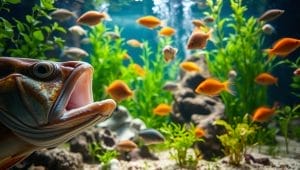
Improper Feeding Schedules and Quantity
Inconsistent meal times confuse fish digestion cycles. When three family members each offer food throughout the day, portions stack up rapidly. This “kindness chain” often leads to weight gain without anyone realizing the collective impact.
Watch for these signs of schedule issues:
- Leftover meals accumulating after 3 minutes
- Fish showing less interest during designated feeding times
- Multiple feeders not tracking daily intake
Unbalanced Dietary Choices
Using generic fish food for all species often causes overeating. Herbivores nibble constantly but carnivores need specific protein levels. The wrong food type leads to excessive consumption as fish seek missing nutrients.
Match these elements to your tank’s needs:
- Food size (crushed vs whole pellets)
- Nutritional profiles (plant-based vs meat-rich)
- Feeding methods (surface vs bottom-dweller formulas)
Adjusting both schedule and menu helps maintain ideal weight levels. Your fish’s vibrant colors and active swimming will confirm you’ve found the right balance.
Impact of Overfeeding on Fish Health
That extra pinch of food you add “just in case” could be reshaping your fish’s future. What looks like enthusiasm during mealtime often masks weight gain that strains their delicate systems. Let’s explore how nutrition choices ripple through your aquarium’s ecosystem.
Effects on Weight Gain and Nutrient Levels
Visible body changes in fish often signal deeper issues. A rounded belly might seem harmless, but it can press against swim bladders and reduce mobility. Research shows excess energy intake disrupts metabolic balance, making it harder for fish to process nutrients effectively.
Watch for these warning signs:
- Difficulty maintaining buoyancy or vertical position
- Lethargy during normally active periods
- Food particles ignored after initial feeding
Surprisingly, fish consuming large meals may still lack essential vitamins. Their bodies prioritize storing fat over absorbing nutrients when levels exceed natural needs. This imbalance weakens immune responses, leaving them vulnerable to parasites and infections.
Healthy growth differs from problematic obesity in one key way: proportionality. If your fish’s width exceeds their natural shape by 20%, it’s time to reassess portions. Pair observation with weekly fasting days to reset their energy equilibrium and promote vibrant health.
Expert-Recommended Feeding Practices
Your fish’s vibrant colors and energetic behavior start with what’s in their diet—not how much they eat. Top aquarists focus on strategic nourishment that matches natural behaviors while keeping tanks clean. Let’s explore how to craft meals that satisfy nutritional needs without overwhelming your aquatic ecosystem.
Choosing the Right Type of Food for Your Fish
Species-specific formulas make all the difference. Carnivorous fish thrive on protein-rich pellets, while herbivores need algae wafers. Consider these factors:
- Natural feeding zones (surface vs bottom dwellers)
- Food texture preferences (slow-sinking flakes vs fast-dissolving tablets)
- Life stage requirements (fry formulas vs adult blends)
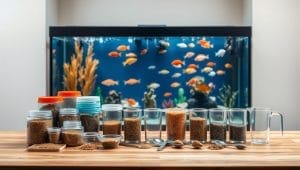
Rotate between freeze-dried bloodworms and vegetable-based options to prevent menu boredom. This variety encourages natural foraging instincts while covering all nutritional bases.
Establishing Optimal Feeding Intervals
Consistency beats quantity every time. Most fish do best with two small meals per day, spaced 8-12 hours apart. Follow this simple routine:
- Offer portions they finish in 2 minutes
- Use a dedicated feeding ring to monitor intake
- Skip one day weekly to reset digestion
Track meals in a notebook or app for three weeks. You’ll spot patterns like increased hunger during warmer water temperatures or slower eating as fish age. Adjust amounts gradually—sudden changes stress aquatic life.
Practical Steps to Prevent Overfeeding Problems
Your fish’s mealtime enthusiasm can reveal more than just appetite—it’s a window into their nutritional needs. By learning their unique language of hunger fullness, you’ll create meals that energize without overwhelming. Let’s explore how thoughtful observation becomes your greatest tool for maintaining ideal body conditions.

Reading the Signs of Satisfaction
Watch closely during feeding sessions. Healthy fish show focused interest initially, then gradually slow their eating pace. When they start ignoring sinking flakes or spit out pellets, it’s nature’s way of saying “enough.” These subtle cues help you determine when to stop offering food.
Track physical changes weekly. A fish’s side profile tells the story—if their midsection appears rounded beyond natural contours, adjust amounts downward. Species like goldfish often develop obesity issues when portions exceed their active lifestyles.
Try these measurement strategies:
- Use a teaspoon to pre-portion dry food
- Install a floating feeding ring to contain flakes
- Note consumption time with a kitchen timer
Consistency matters more than quantity. If three fish ignore food after 90 seconds, reduce tomorrow’s offering by 25%. This response-based approach prevents waste while keeping weight in check. Within weeks, you’ll notice improved activity levels and clearer water.
Optimizing Nutrition for Vibrant Aquatic Life
Your fish’s vibrant hues and lively antics aren’t just for show—they’re nature’s report card on their diet. Crafting meals that match their energy needs prevents obesity while enhancing natural beauty. Think of their food as paintbrushes—the right blend creates living masterpieces in your tank.
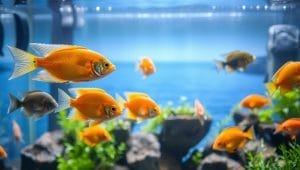
Start by balancing proteins, fats, and carbs. Carnivores thrive on 40-50% protein, while plant-eaters need fiber-rich options. This balance stops unhealthy weight gain and supports scale shimmer. Use these portion guidelines:
- Juveniles: 3-4 small meals daily for growth
- Adults: Two feedings with controlled calories
- Breeding fish: Extra protein during spawning periods
Rotate between flakes, pellets, and frozen treats to cover all nutrients. Fish that chase sinking wafers or inspect floating flakes show ideal eating behaviors. Their energy levels will stay steady without midday slumps.
Notice faded colors or slow movements? These signal nutritional gaps. Our complete guide to fish nutrition helps tailor meals to your species’ needs. You’ll learn how to adjust portions as fish age—reducing weight risks while maintaining that dazzling underwater glow.
Adjusting Feeding Techniques Based on Aquarium Size and Species
Imagine your fish swimming through currents that mimic their natural habitats—their feeding patterns change with every ripple. Your tank’s dimensions and community mix determine how nutrients flow through this miniature ecosystem. By aligning meals with these factors, you create a dining experience that supports health without excess.
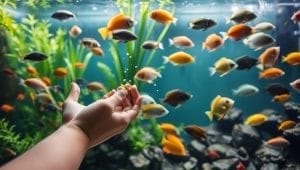
Custom Meals for Diverse Appetites
Small tetras and large cichlids need different approaches. For nano fish, use crushed flakes they can swallow whole. Bigger species benefit from slow-sinking pellets that encourage natural hunting behaviors. Observe how quickly each type consumes meals—adjust portions to match their eating speed.
Try these portion guidelines:
- 1-2 pellets per medium fish per day
- Pinch of flakes covering a dime’s surface area for small groups
- Fast-growing juveniles: 3 micro-meals daily
Smart Tools for Precision Feeding
Upgrade your routine with equipment that prevents weight gain. Floating rings keep surface food contained, while turkey basters deliver targeted meals to bottom dwellers. These methods reduce waste and help shy fish get their share without competition.
Rotate these tools weekly:
- Automatic feeders for consistent time intervals
- Long tweezers for placing food in specific zones
- Gel-based feeders that dissolve slowly
Notice fish lingering near feeding areas after meals? Space out portions across the tank to promote exercise. This mimics wild foraging patterns while managing weight. Your community will thrive when every species gets meals tailored to their needs and environment.
Integrating Routine Maintenance and Water Quality Checks
Your aquarium thrives when care becomes a rhythm rather than a chore. Pairing smart feeding habits with consistent upkeep creates an environment where fish flourish naturally. Let’s explore how simple routines protect your aquatic friends while keeping water crystal clear.
Scheduling Regular Tank Cleanings
Set a weekly 15-minute session for these essential tasks:
- Test ammonia and nitrate levels with liquid kits
- Vacuum gravel to remove hidden food particles
- Wipe algae from glass using a magnetic cleaner
Notice cloudy water between cleanings? This often signals excess waste from uneaten meals. Adjust portions slightly and retest after three days. Your aquarium fish health guide helps decode these subtle changes.
Ensuring a Balanced Aquarium Ecosystem
Monthly 25% water changes reset your tank’s chemical balance. Track these details in a simple table:
- Feeding amounts and fish activity levels
- Water temperature and pH readings
- Cleaning dates and filter maintenance
Healthy fish maintain lean body shapes when their environment stays stable. If you spot rounded bellies during weekly checks, reduce portions by 10% over two weeks. This gradual approach prevents stress while managing weight effectively.
Leveraging Technology and Tools for Better Feeding Regulation
Your smartphone could become your aquarium’s best dining companion. Modern tools take the guesswork out of meal management while keeping your fish in peak condition. Let’s explore how smart devices help maintain your tank’s balance even when life gets busy.
Smart Feeders: Precision Portion Control
Automated systems like the Eheim Everyday dispense exact amounts at set hours. Programmable timers ensure two small meals per day, matching natural feeding rhythms. These devices prevent accidental weight gain by eliminating human error in portion sizing.
Digital Tracking for Healthier Fish
Apps like Aquarimate log your fish’s body measurements and eating patterns. Snap weekly top-view photos to monitor for signs of obesity. The app’s graph feature shows trends in food intake versus activity levels, helping you adjust portions proactively.
Try this three-step tech integration:
- Sync your feeder with a smart plug for remote control
- Use floating food cameras to observe meal behaviors
- Set phone reminders for monthly system checks
When vacation strikes, these tools maintain your routine. You’ll return to vibrant fish rather than dealing with cloudy water from well-meaning pet sitters. Technology becomes your silent partner in creating sustainable habits that protect aquatic health.
A Final Word on Achieving a Balanced Aquarium Environment
Every meal you offer shapes the underwater world in ways more profound than you might realize. Medical studies confirm what observant aquarists know—recognizing hunger cues and fullness signals prevents weight gain while promoting longevity. Your fish’s lean body shape and active behavior become the ultimate indicators of success.
Consistency proves crucial. Stick to measured portions at set hours, using timers or apps if needed. Research shows tanks with stable feeding routines maintain better water balance and healthier fish. Watch for natural stop eating behaviors rather than relying on fixed amounts.
Remember, your aquarium thrives through harmony. Combine smart intake control with regular water tests and species-specific care. Whether using automatic feeders or manual checks, focus on sustaining energy levels without excess. Your efforts create a self-regulating system where life flourishes naturally.
You now hold the tools to nurture aquatic vitality. Trust your observations, embrace gradual changes, and celebrate each clear-water day as proof of your balanced approach. Your tank isn’t just surviving—it’s radiating health through every thoughtful feeding choice.
FAQ
How often should I feed my fish to avoid health issues?
Most fish thrive with 1–2 small feedings daily. Adjust based on species needs—fast-moving fish like tetras may need more frequent meals, while slower species like bettas do well with less. Always observe their behavior and remove uneaten food within 2 minutes.
What are the visible signs my fish are getting too much food?
Look for leftover food sinking to the substrate, cloudy water, or algae blooms. Fish may appear sluggish, develop swollen bodies, or show reduced interest in eating. Regular water testing can also reveal spikes in ammonia or nitrates caused by excess waste.
Can I use an automatic feeder to prevent feeding mistakes?
Yes! Automated feeders like the Eheim Everyday Fish Feeder help maintain consistent portions and schedules. Pair this tool with manual checks to ensure it’s calibrated correctly for your fish’s size and dietary needs.
How does overfeeding harm my aquarium’s water quality?
Uneaten food decays, releasing toxins like ammonia and disrupting the nitrogen cycle. This stresses fish and promotes harmful algae growth. Weekly water changes (20–25%) and a gravel vacuum can help restore balance.
What’s the best way to adjust feeding for mixed-species tanks?
Offer a variety of foods, such as floating pellets for surface feeders and sinking wafers for bottom dwellers. Separate aggressive eaters during meals if needed. For example, cichlids and guppies often require different portion sizes and feeding styles.
How long does it take to fix issues caused by excess food?
Improvements start within days of reducing portions and cleaning the tank. Full recovery depends on the severity—consistent maintenance and monitoring for 2–3 weeks typically restore water clarity and fish health. Patience is key!
Are certain fish more prone to weight gain from extra food?
Yes. Goldfish, cichlids, and plecos are notorious for overeating. Stick to species-specific guidelines—for example, goldfish benefit from high-fiber pellets and occasional veggie treats instead of constant feeding.
Can I train my fish to recognize hunger cues better?
Fish learn routines quickly! Feed them at the same times daily, and use a tapping signal before adding food. This helps them associate the cue with mealtime, reducing frantic begging behavior that might tempt you to overfeed.





